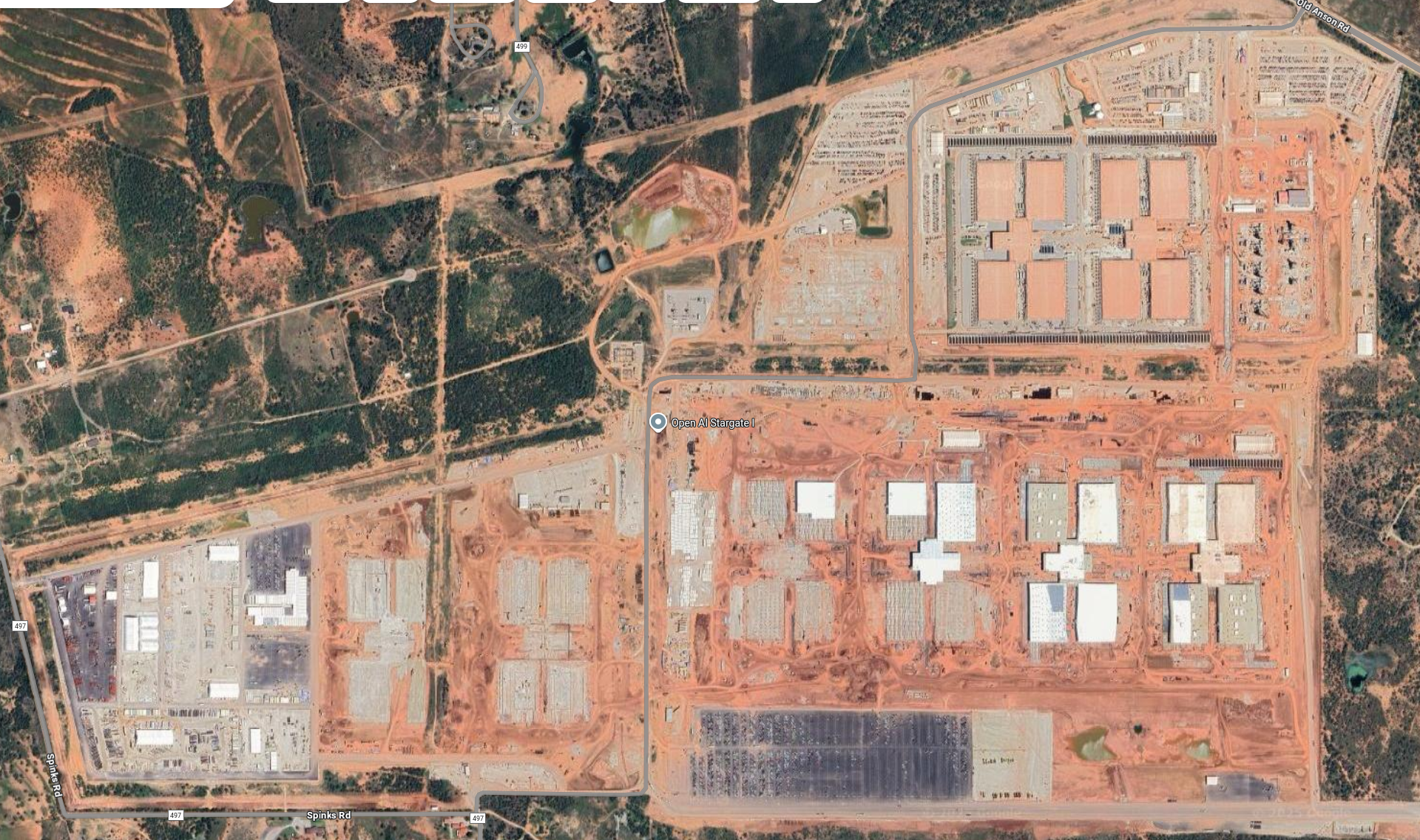Is the Magnitude of AI Capex Risky?
 OpenAI stargate 1 complex in Abilene, TX
OpenAI stargate 1 complex in Abilene, TX
The concerns of a bubble are creeping into every conversation related to markets or AI lately.
But unfortunately for the naysayers, which seem to be dismayed mostly by stock prices, I don’t see any reason for the music to stop.
Let’s put it plainly: the companies doing all of the AI capex have hundreds of billions of dollars of free cash flow to burn and fortress balance sheets. The capex spend is not an existential risk to them.
The existential risk would be totally missing the latest AI revolution, from which they would not be able to recover. They can easily recover from blowing a single year’s free cash flow on data center investments, which is arguably much more valuable no matter what than whatever e.g. Zuckerberg’s 2021 Metaverse pivot amounted to (maybe that still yields something! But it hasn’t really hurt them much!).
Lastly, I have to point out that the massive capex spending is now fully deductible from income year 1. Thanks to the Big Beautiful Bill, you can depreciate 100% of your capex in the first year. This is a big deal in terms of allowing companies to pull forward spending they might have rather spread out over several years before.
The incredible Free Cash Flow of the Mag 7
| Rank & company (ticker) | Market value (approx., mid‑2025) | Most recent free cash flow (FCF) | Cash & cash equivalents* | 2025 AI capex (reported) | Evidence for AI capex | Estimated tax benefit of OBBB bonus depreciation (21 % of capex) | Notes |
|---|---|---|---|---|---|---|---|
| #1 NVIDIA (NVDA) | ≈$4.505 T | Fiscal 2025 free cash flow $60.724 B | Cash, cash equivalents and marketable securities $43.2 B at FY 2025 year‑end | No major AI‑infrastructure capex announced – NVDA supplies AI chips but isn’t building hyperscale data centers. | – | ≈$0 | Chip manufacturer; demand from hyperscalers drives revenue. |
| #2 Microsoft (MSFT) | ≈$3.894 T | FY 2025 free cash flow $71.611 B | Cash & short‑term investments $94.565 B for FY 2025 | ≈$94 B – analysts project Microsoft’s 2025 capex to reach ~$94 B; this spending surge is aimed at building AI‑oriented data‑center capacity. | R&D World notes that analysts expect Microsoft’s total capex for 2025 to be about $94 billion, an 83 % year‑over‑year increase, to fund AI‑centric data centers. | ≈$19.74 B (0.21 × $94 B) | Microsoft indicated that a large portion of its record capex will fund AI‑optimized data centers; the OBBB allows an immediate deduction of qualified AI infrastructure, reducing taxes by ≈$19.74 B if fully used. |
| #3 Apple (AAPL) | ≈$3.806 T | FY 2024 free cash flow $108.807 B | Cash & cash equivalents $55.372 B at Jun 30 2025 | ≈$1 B – Apple said capex will grow due to AI; Q3 2025 capex was $3.46 B and management indicated that up to $1 B will be spent on Nvidia GB300 NVL72 systems for AI. | During Apple’s Q3 2025 earnings call, executives noted that capex is rising because of investments in private cloud infrastructure and they expect to spend up to $1 billion on Nvidia NVL72 systems for AI. | ≈$0.21 B (0.21 × $1 B) | Apple generally runs a very cash‑rich business; AI capex remains modest relative to peers, so the tax benefit is small. |
| #4 Alphabet (GOOGL) | ≈$2.979 T | FY 2024 free cash flow $72.764 B | Cash & short‑term investments $95.148 B at Jun 30 2025 | ≈$75 B – Alphabet plans to increase capex to $75 billion in 2025 to build AI‑focused server capacity. | R&D World reports that Alphabet announced plans to boost capex to $75 B in 2025, a significant increase from $52.5 B the prior year. | ≈$15.75 B (0.21 × $75 B) | Google executives said most capex will go toward chips and data‑center infrastructure that support AI services. |
| #5 Amazon (AMZN) | ≈$2.365 T | FY 2024 free cash flow $38.219 B | Cash & short‑term investments $93.180 B at Jun 30 2025 | ≈$100 B – CEO Andy Jassy said 2025 capex could exceed $100 billion, noting that the “vast majority” of Q4 2024 capex ($26.3 B) was for AI in AWS. | R&D World notes Amazon’s capex target for 2025 could exceed $100 B and that Jassy said the “vast majority” of the $26.3 B capex in Q4 went to AI for AWS. | ≈$21 B (0.21 × $100 B) | Amazon is dramatically increasing data‑center investment to support AWS AI services; OBBB’s bonus depreciation could reduce taxes by ≈$21 B if the infrastructure qualifies. |
| #6 Meta Platforms (META) | ≈$1.791 T | FY 2024 free cash flow $54.072 B | Cash & short‑term investments $47.071 B at Jun 30 2025 | ≈$65 B – Meta expects to spend up to $65 B in 2025 on AI‑focused capex. | The R&D World article reports that Meta CEO Mark Zuckerberg signaled capex of up to $65 B in 2025, compared with $39.2 B in 2024. | ≈$13.65 B (0.21 × $65 B) | Meta is expanding its own data‑center footprint to support generative‑AI and mixed‑reality services. |
| #7 Broadcom (AVGO) | ≈$1.588 T | FY 2024 free cash flow $19.414 B | Cash & cash equivalents $10.718 B at Jul 31 2025 | No AI capex disclosed – Broadcom sells semiconductors and networking chips but has not announced large AI‑infrastructure capex. | – | ≈$0 | Company benefits from selling AI chips to hyperscalers; not a major spender on data‑center capex. |
| #8 Tesla (TSLA) | ≈$1.440 T | FY 2024 free cash flow $3.584 B | Cash & equivalents $36.78 B as of Jun 2025 | ≈$1 B – Tesla’s Q1 2025 earnings call noted that AI‑infrastructure capex was $1 billion and that the company had installed 35,000 H100 GPUs. | DataCenterDynamics reports that Tesla said its AI‑infrastructure capex was $1 B in Q1 2025, with plans to install tens of thousands of Nvidia GPUs. | ≈$0.21 B (0.21 × $1 B) | Tesla invests mainly in AI training systems for autonomous‑driving software; other capex relates to factories and EV production. |
| #9 Berkshire Hathaway (BRK.B) | ≈$1.083 T | FY 2024 free cash flow $11.616 B | Cash and short‑term investments $344.09 B at Jun 2025 | None – the conglomerate is not pursuing AI infrastructure spending; capex is dominated by insurance, railroad and utilities subsidiaries. | – | 0 | Berkshire’s cash hoard is invested in T‑bills and equity stakes; it is not building AI data centers. |
| #10 JPMorgan Chase (JPM) | ≈$0.846 T | FY 2024 free cash flow –$42.012 B (negative) | Cash & equivalents $425.9 B for the fiscal quarter ending Mar 2025 | No AI capex disclosed – the bank invests in technology but has not announced large AI‑infrastructure capex. | – | 0 | As a regulated bank, JPMorgan invests primarily in software and digital‑banking innovations; major AI‑server purchases would likely be modest relative to its asset base. |
Revenues Upstream
It’s now looking quite possible that my previous blog post where I tried to model out revenue for the various main consumer AI companies was sandbagged.
It now seems possible that OpenAI could hit 50 billion in forward revenue by EOY 2026.
How?
- They are at 800 million weekly active users today
- Revenue on API subscriptions + enterprise + consumer is likely 13 ARR billion today
- They added profit share “buy from ChatGPT” with Etsy & Shopify 2 weeks ago.
- They will be able to monetize free-tier ChatGPT with ads
- They shipped an app store this week & will be able to monetize that.
Anthropic may have an even simpler path:
- They are the most favored AI coding tool
- Their prices are so high they must already have good margins
- They can lean more into code + agents + enterprise
- They can ship a GitHub alternative that:
- also has CI built in
- also has deployments built in (like Heroku or Vercel)
- also has monitoring and telemetry built in
End to end they can build a platform that writes, builds, runs and monitors your code for your business. They could charge massive premiums if this all works well. It’s just up to them to actually execute on this, because if they don’t OpenAI could also easily do this, and they seem to be capable of shipping aggressively. They have all the pieces in place already to do it.
In my personal experience I can tell you that exactly one year ago (Oct 2024) the AI coding tools only started to be useful. Now they are so good they don’t even make that many mistakes, it’s mostly just corrections around business logic for things they could never possibly know.
I would guess the average developer in the first world now spends between $20 to $200 a month on AI coding tools.
Revenue Upstream vs Capex
If you figure the actual capex spend (which Dylan Patel of SemiAnalysis puts at 450 billion projected next year (2026) but most analysts put it at 350 billion), this is basically covered by Mag 7 free cash flow.
However, if we consider that we are finally seeing real productivity from the models, I think it’s very likely we get 100 billion consumer AI revenues by EOY 2026 total. That is considering we’re likely close to 50 billion by EOY 2025; it’s not a crazy trajectory.
So if you have 100 billion of revenue vs 350 billion capex, that’s not terrible. That’s actually pretty normal. But the next year there might be 250 billion in AI revenues after that, and capex will likely be slowing and leveling off if not outright declining.
My point is it’s possible for this situation to resolve without some kind of horrendous crash as long as it’s not overdone. Right now, yes stock prices seem high, but if stocks fell 10 or 20 percent from here would you still think that?
Outside of the private markets, the clear and obvious bubbles are unrelated to AI - it’s stuff like quantum computing which has no revenue, but also no real impact on anything because they don’t have customers either.
Of course this is not financial advice and the stock market can go down 30% in a month starting any day of the year, etc etc.
